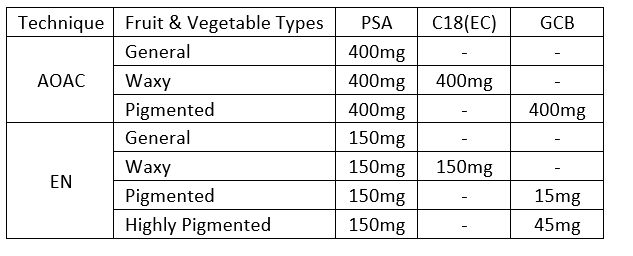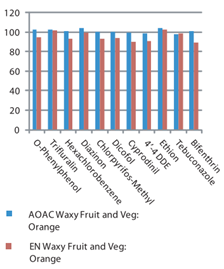Jul 6, 2023 2:15:41 PM
How do I know what the best QuEChERS cleanup mix is for my samples?
By Deanna Bissonnette

You may have already read the previous blogs about QuEChERS (Quick, Easy, Cheap, Effective, Rugged, Safe) extraction and cleanup, but, if you have quite a few different matrix interferences or analytes that you’re trying to remove or recover, it’s important to ensure that you’ve chosen the right sorbent for the job. Depending on if you’re following the Association of Analytical Communities (AOAC) or the European Norm (EN) approach, this can also dictate the type of cleanup that you’ll be able to use for your samples.
Now, you’ll want to start with, “what are my analytical objectives?” These can be different for every lab, but this can also vary from sample to sample within a lab.
Screening:
This technique is for a very wide range of analytes (i.e. multi-residue pesticides) and only moderate sensitivity is needed for this type of analysis. So, you don’t need an extensive cleanup for this type of sample, a moderate to low cleanup should suffice. Since this technique typically will include large lists of analytes (>100), QuEChERS extraction and cleanup are often utilized due to its ease of implementation in the laboratory. However, it’s important that the laboratory selects the optimal QuEChERS cleanup mixture, which can include a variety of solid phase extraction (SPE) media. The trick here is to effectively remove the matrix analytes (i.e. fats, lipids, pigments) without removing the analytes of interest (i.e. pesticides) from the final extract, which would compromise the final result.
Targeted:
This technique is exactly as it sounds. You’re looking for specific analyte(s) or class of analytes (i.e. acrylamide or mycotoxins) within a sample. As you can imagine, in many cases, you’ll need high sensitivity for this type of analysis to ensure you’re able to quantify the targets effectively. Thus, you’ll need to make sure these types of samples undergo an extensive extract cleanup, and they may even need to be concentrated a bit to enrich the analytes within the extract prior to analysis. For these techniques, QuEChERS extraction and cleanup may not meet the criteria for analytical sensitivity and therefore a more selective technique is often implemented.
As you can see from the two possible analytical goals above, the cleanup sorbent and technique is very important to ensure you can effectively quantify (if needed) the analytes within that specific sample.
So, for laboratories interested in multi-residue pesticide analysis, QuEChERS is likely the perfect technique for you! However, the question still remains, what is the best QuEChERS cleanup mix for your sample types? Well, the first thing you might remember from the previous QuEChERS cleanup blog, is that there are two different ways you can perform QuEChERS cleanup with your extracts. This can be done either by dispersive-SPE (d-SPE) or pass-through column SPE (c-SPE). Once you have decided on one of these two options, the next step is to select the optimal SPE sorbent for the job. Let’s look at what sorbents are commonly utilized for QuEChERS cleanups.
Whether you’re utilizing AOAC or EN QuEChERS cleanup techniques, there are three common SPE sorbents that are used depending on the type of samples. The first sorbent contains primary and secondary amine functional groups such as ISOLUTE® PSA. This sorbent is a weak anion exchanger and is great for removing acidic interferences like your fatty acids and anthocyanins. The next sorbent is C18 which contains 18 carbon chain functional groups that provide a hydrophobic surface for removing your non-polar interferences commonly present in your waxy samples, like oranges. Typically C18 sorbent in dSPE is the end-capped version, such as ISOLUTE® C18(EC), which is effective at minimizing those unwanted secondary interactions that are usually responsible for reduced analyte recovery. The final sorbent commonly used is graphitized carbon black (GCB), which is highly effective in removing interferences such as chlorophyll and other pigments from samples like spinach. Use caution with GCB if your target analytes are planar pesticides. The media strongly interacts with these structure types thus having a detrimental effect on your recovery! Below is a chart showing the various amounts of SPE medias in traditional AOAC and EN QuEChERS cleanups for various types of fruits and vegetables.

In the figure below, you’ll find the recovery data of some pesticides using the AOAC and EN QuEChERS cleanup for waxy samples (in this case it was an orange) using ISOLUTE® QuEChERS. All the recoveries are above 80% regardless of the technique used (AOAC or EN). The media used to cleanup the matrices in your samples, is super important for the performance and quantitation of the target analytes present within that sample.

Even though there are many different types of media mixtures for QuEChERS, it is imperative that you follow the cleanup procedure that pertains to the matrix of your sample. You also must consider your analytical objectives as well when determining the best way to tackle your fruit and vegetable sample matrices. If you’re not looking for very much sensitivity and a wide range of analytes present, then it’s probably safe to say a general cleanup would suffice. On the other hand, if you’re looking for specific targets and quantitating those specific targets, you’re going to want a more in-depth and effective cleanup to be able to quantify those target analytes.
For more information, view our latest webinar.
Published: Jul 6, 2023 2:15:41 PM

